Now that 2024 has passed, it’s time to reflect on my grayling fishing reports since the trout fishing season ended. As temperatures drop in October, grayling begin to feed heavily and bulk up in preparation for the leaner winter months.
So, how has the Welsh Dee fished during the final three months of the year…
October Grayling Fishing Report
October is typically a wonderful month for enjoying the rewards of grayling fishing and admiring the trees developing their stunning red, orange, yellow, and brown autumn colours.
Heavy rain at the end of September caused the Welsh Dee to flood. After a few days of dry weather, the upper beats cleared, so I went to fish for grayling on the Bala Angling Club beat at Llandderfel.
Grayling Fishing at Llandderfel – 2/10/24
When we arrived at the car park at 10 a.m., the weather was mild (16 degrees Celsius), gloomy, and breezy. The river was running clear, but the level was high (0.53m @ Bala gauge), which would limit the pools worth fishing. We chose to cross the road bridge from the car park and fish down the right bank from A to C.
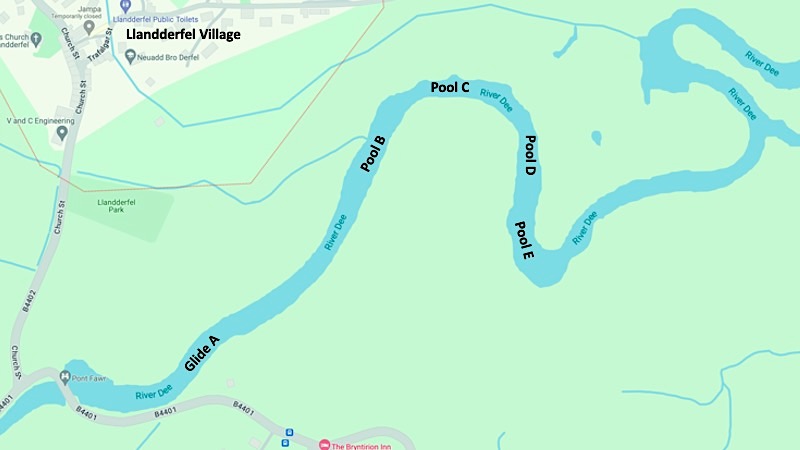
Walking down to the river from the access gate on the B4410 took us to the head of Glide A. In high water, this glide contains two features that often hold grayling:
- a deep pocket behind the large rock at the head of the glide, and
- the channel close to the far bank that flows into a tree-lined pool below.
Graham selected to fish glide down into the tree-lined pool with a team of wet flies, leaving me to fish the deep pocket at the head of the glide.
To fish the deep pocket, I set up my 10ft 3wt Nymphmaniac fly rod to fish three nymphs spaced 18” apart on 4lb fluorocarbon (point: #12 olive & copper tungsten jig-back nymph; middle dropper: #14 black pheasant tail nymph 3mm silver TB; top dropper: size 16, hares ear nymph with a 2.5 mm gold TB).
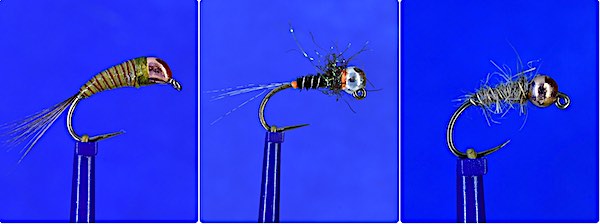
Staring at the tail of the pocket, I fished upriver towards the large rock. After catching a small grayling on the hare’s ear nymph, a bigger grayling fell for the black PTN.
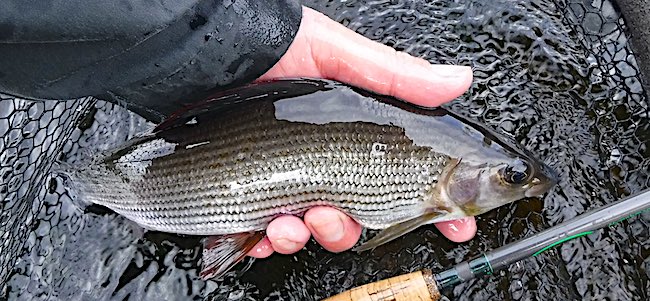
I fished down the glide towards Graham but it didn’t produce any more grayling euro nymphing.
Graham fished the glide with a team of wet flies but only managed to catch a couple of small grayling. So, we moved downriver to fish the pool (B) directly below the tree-lined bank.
After losing two small grayling in the fast run at the head of the pool, I had a solid take and my rod bent around into a bigger fish that took off downriver. Carefully, I got it under control and netted a lovely grayling that had fallen for the black PTN on the middle dropper.

Nymphing the remainder of the pool produced 3 additional grayling that were fooled by either the Black PTN or the hare’s ear nymph on the top dropper.
Graham persevered with the wet flies and he was rewarded with a couple of nice grayling near the tail of the pool…
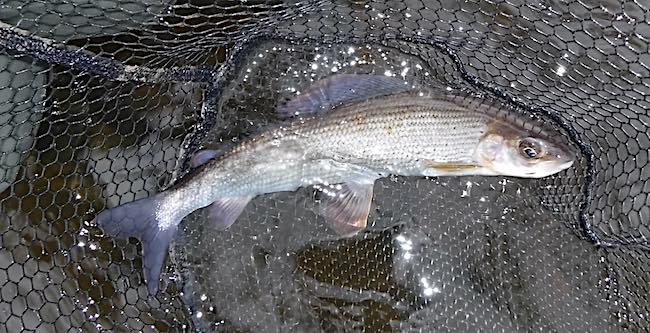
For the final hour of the day, we moved downriver to fish fast run at the head of pool E. Graham switched to fishing a similar nymphs setup to me and was rewarded by finishing the day a lovely Welsh Dee grayling and a few smaller fish on a hare’s ear.
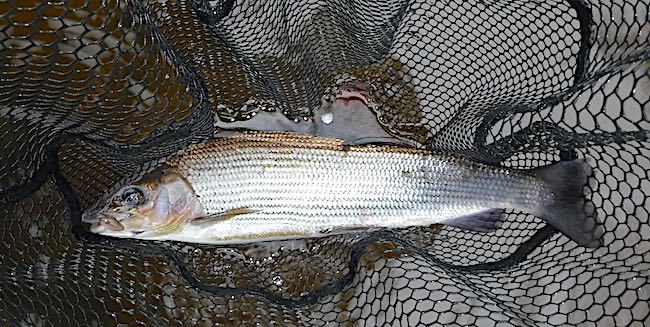
When the light started to fade we headed back to the car, pleased with the beautiful grayling we’d caught.
Llangollen Grayling Fishing Report
By 14/10/24, the river level had fallen further since my last visit, reaching a suitable level (0.59m @ Manley Hall) for fishing the upper beat of Llangollen-Maelor’s upper beat.
Dry Fly fishing the Pipe Pool
It was a cold start to the day, but I noticed some up-winged flies hatching on the way to the Pipe Pool. I noticed a few grayling rising in the pockets of slack water at the head of the pool, which was a good sign for dry fly fishing.
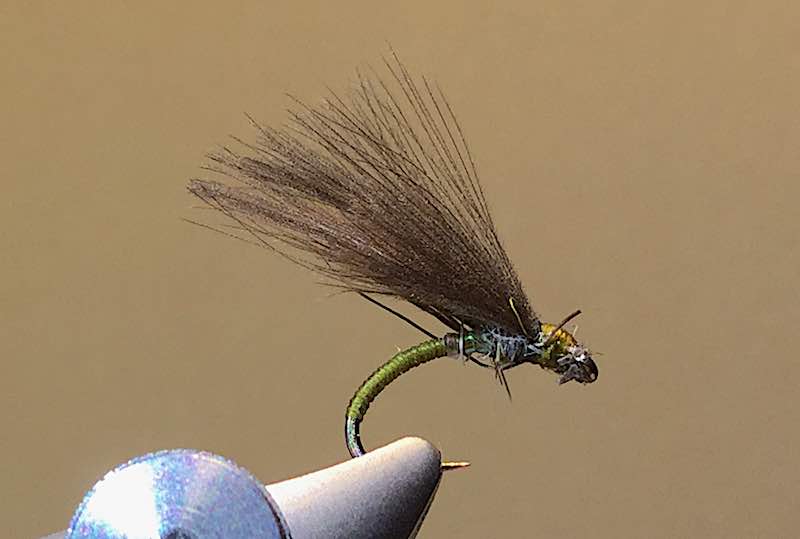
To get out of the “starting block”, I targeted the rising grayling in the pockets with a #14 CDC Olive dry fly.
It was difficult to see the fly on the water but I heard a fish rise where I thought my fly was and instinctively raised my rod…
HOOKED, the grayling took off down the main channel.
After a short struggle, I gained the upper hand and guided the grayling out of the fast water and safely into the net.
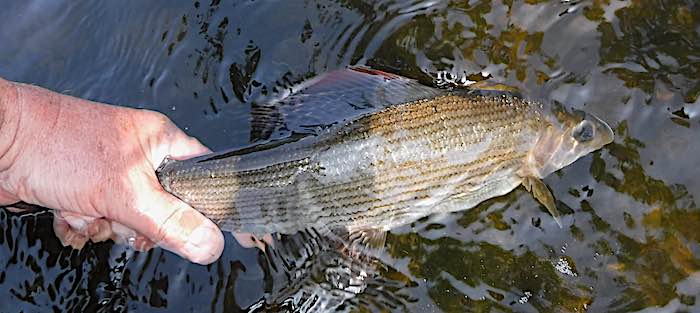
Fishing the remainder of the Pipe Pool with the dry fly resulted in two more tiny grayling. Then it was time to head upstream to fish Glide Pool.
Fishing the Glide Pool with a team of Wet flies
I didn’t see any fish rising in the main section of the Glide Pool. Therefore, I moved up to fish the riffle above with a team of wet flies spaced 3ft apart on a 3lb copolymer leader (point: #14 pheasant tail nymph; middle dropper: #14 black hopper; top dropper: #14, March Brown Spider).
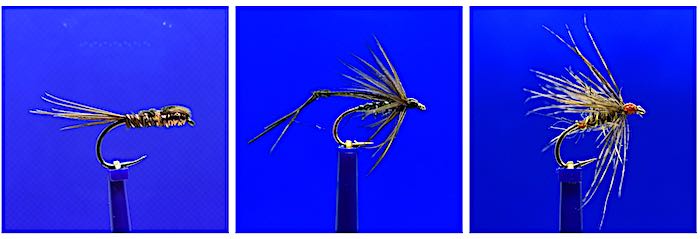
Most of the streamer weed that grows in the riffle had been torn off the riverbed in the recent floods, making it easier to fish the riffle with the wet fly.
Starting at the bottom of the riffle, I slowly fished upriver searching the slacker pockets and seams with the wet flies. In the first section of slack water, my line darted upriver and when I lifted the rod a…
grayling ‘boiled’ on the surface and then darted downriver.
Carefully, I gained the upper hand and guided it safely into the net. The grayling had taken the March Brown Spider on the top dropper.
Fishing the remainder of the riffle produced another two grayling, which also fell for the March Brown Spider.
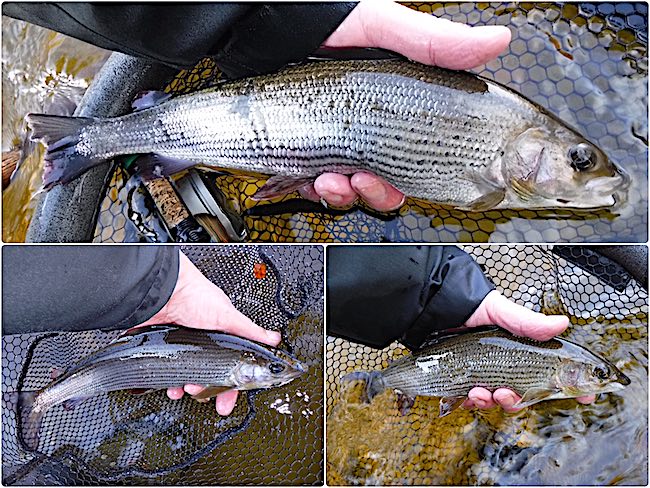
Next, I walked upriver to fish Dee Farm…
Fly fishing Dee Farm
In the tail of Dee Farm, I spotted a few grayling taking flies at the surface.
Keeping low a profile against the bank, I covered the fish rising close to the near-bank with the CDC Olive. The Olive was taken as soon as the fly drifted into its feeding zone but lifting into the take failed to hook the fish.
The other rising grayling just ignored the Olive. Therefore, I switched to the wet fly and fished towards the tail.
On the far side of the 1st submerged rock, I caught a grayling that had taken the Black Hopper.
Further downriver I caught a smashing grayling on the March Brown Spider, which disturbed the remainder of the pool.
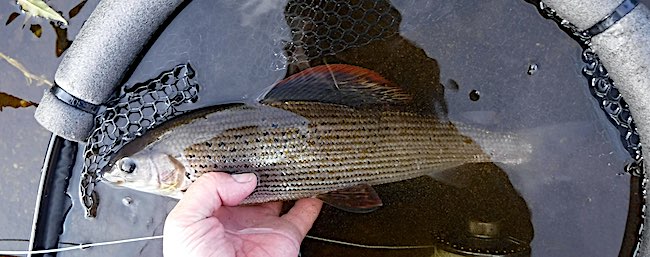
On my way upriver to the top of the beat, I stopped off to fish the fast run at the head of the Fridge Pool.
The Fridge Pool – Tigh line nymphing for Grayling
I didn’t see any fish rising, so I decided to fish the main channel that is 4-5ft deep with a team of three nymphs (point #12 olive tungsten jig-back nymph; middle dropper #16 peacock quill perdigon nymph with a purple collar and a 2mm silver TB; top dropper #16 Hare’s Ear with a 1.5mm copper TB).
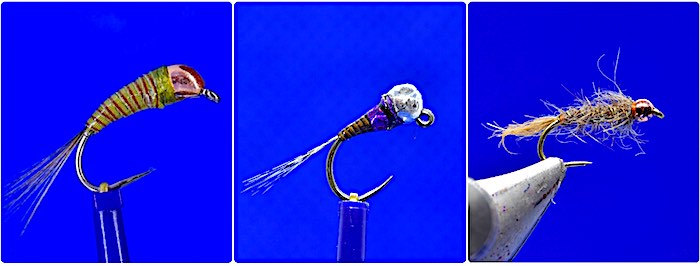
I’m using a heavy point fly to get the flies quickly to the riverbed, which is where the grayling are often feeding in this fast run. On fishing towards the head of the run, I missed a couple of fast takes before hooking and landing a lovely grayling on the copper jig-back nymph.
The grayling seemed thin on the ground, so I embarked on the long walk through the wood to fish the Top Pool in search of more grayling.
Fishing the Top Pool on the Welsh Dee
At 0.59 m, the river height was good for fly fishing the Top Pool for grayling. I didn’t see any surface activity while I rested from my walk. Therefore, starting at the tail, I fished the team of nymphs upriver. Progress was slow and after catching a few small grayling I caught two better fish on the 16 Hare’s ear nymph on the top dropper.
To finish the day I switched back to the wet fly setup and fished across and down through the pool.
The first cast into the margins on the far bank produced a take and as the line tightened a large grayling surfaced, which…
almost, immediately “threw” the hook.
A couple more casts later, another grayling boiled on the surface and darted downriver in the fast water.
This time, I carefully got control of the situation and netted a lovely grayling that had been fooled by the black hopper.
Over the next 30 minutes, grayling savagely attacked the wet flies and I caught several more on the March Brown spider and one OOS trout on the Black Hopper. This topped off a great day fishing for grayling on the Welsh Dee.
November Grayling Fishing Report
The fine weather continued, which helped the river level fall to 0.54m (Manley Hall gauge). High pressure was in charge, and it was great to be out fishing with Graham in the sunshine on the beautiful Welsh Dee.
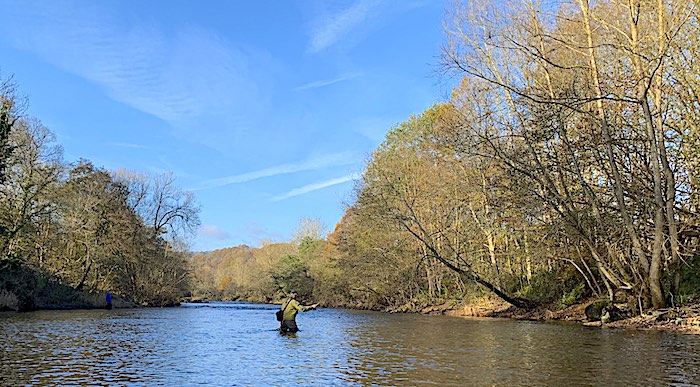
The plan for the day was to show Graham how to fish the Dee from just below Pont Cysyllte Aqueduct down to the Long Meadows pool, which he’d not fished before.
Fly fishing Llyn-y-Boat Pool
The Lyn-Y-Boat pool was the first place we stopped to fish, which often holds some lovely grayling. While describing where and how to fish the pool, we noticed a couple of fish rising in the tail. They were feeding in the foam channel, although it was unclear what they were consuming.
I suggested a #16 Griffith Gnat dry fly usually works because they were probably feeding on small midges. Graham duly tied on and approached the rising fish from a downstream position. After a few casts, one of the fish grabbed the fly and caught his first grayling of the day.
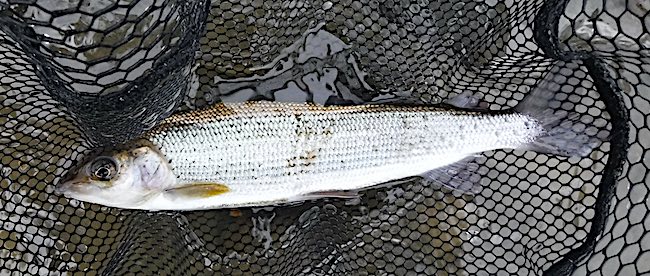
The fish stopped rising and he didn’t have any more offers, so we headed downriver to fish the Long Meadow Pool.
Long Meadow Grayling Fishing Report
There was no evidence of rising fish, so I selected to fish a two-nymph setup spaced 18″ apart on a 4lbs fluorocarbon leader:
- point: #12 pheasant tail nymph with a 4mm copper TB and orange collar & tag;
- dropper: #14 black pheasant tail with a purple collar and 3mm silver TB
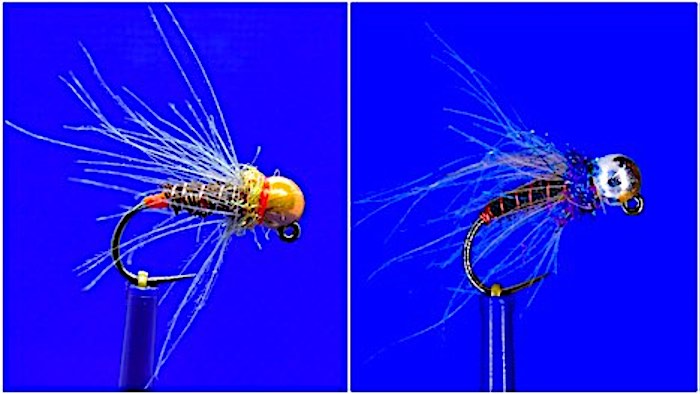
Starting downstream of the faster water, I methodically fished my way across and upriver, covering all possible lays. It wasn’t long until I landed my first grayling, which had fallen for the pheasant tail nymph on the point.
During a snack break, I spotted a few little olives hatching and a couple of rises near the far bank. Therefore, I switched to a 9ft 5# loaded with a floating line, 13ft tapered leader and three wet flies spaced 3ft apart on 3lb copolymer (point: #14 black hopper; middle dropper #14 March Brown spider; top dropper: #14 pearly butt Waterhen Bloa).
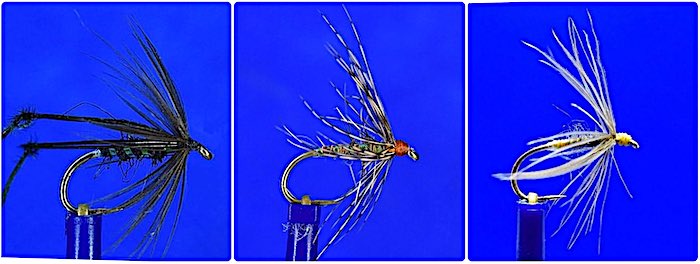
I caught two OOS brown trout that took the black hopper under the overhanging trees close to the far bank.
About halfway down the pool, as the flies swung around to the dangle there was a swirl and my line tightened into a nice fish. After a few tense moments, I slid my net under a lovely Welsh Dee grayling that had fallen for the Pearly Butt Waterhen Bloa on the top dropper.
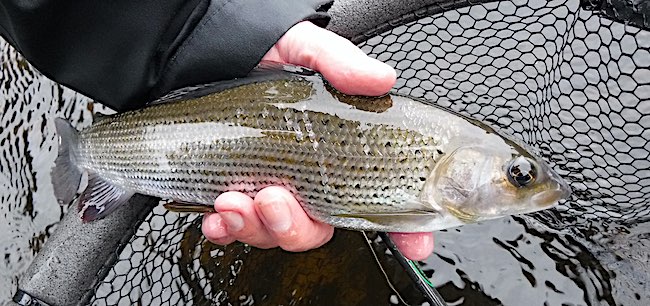
Fishing the remainder of the pool produced two more grayling that were tempted by the March Brown spider and the Bloa.
Graham was pleased with his day fishing the lower beat and when the light began to fail, we headed off home.
December grayling fishing report
This year’s Hanak European Grayling Festival was held on the Welsh Dee from Corwen to Llangollen on November 30th and December 1st. The International Redfins won the competition, catching 38 grayling, a good return given the river conditions. Over the course of two days, the 36 teams returned 588 grayling, with the largest fish measuring an astounding 47.2cm.
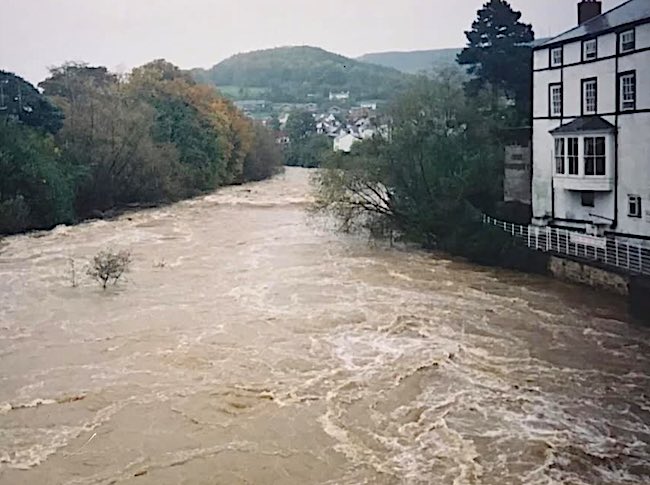
After the competition, the weather turned terrible, with the river level reaching 2.5m (Manely Hall gauge) and the Dee was a washout during December. As a consequence, I’ve not fished the Welsh Dee in December.
Instead, I’ve been exploring a day ticket beat on the River Ribble, which I’ll discuss in a subsequent post.
Hopefully, the New Year will bring some drier conditions, bringing the Welsh to a fishable level during January.
If you are interested in fly fishing on the Welsh Dee there is some excellent day ticket water at Llangollen and Bangor-On-Dee.
Also, you might find my article on Fly Fishing in Winter helpful
Andrew, enjoyed your post as always. A daft question! Do you take more than one rod when out on the river for the day? If not which rod is your go too and why? If more than one ,again what rods? From your comments you clearly are as flexible as possible depending on the conditions, insect life etc. Best Ken
Hi Ken,
I usually take two rods with me. An 11 ft #3 nymphing rod and a 9ft #5 rod that I have set up with either dries or spiders.
I hope this helps, Andrew
Very very interesting and very informative to a newbie like myself. Thank you very much.
Great to hear you enjoyed it.
Tight lines, Andrew